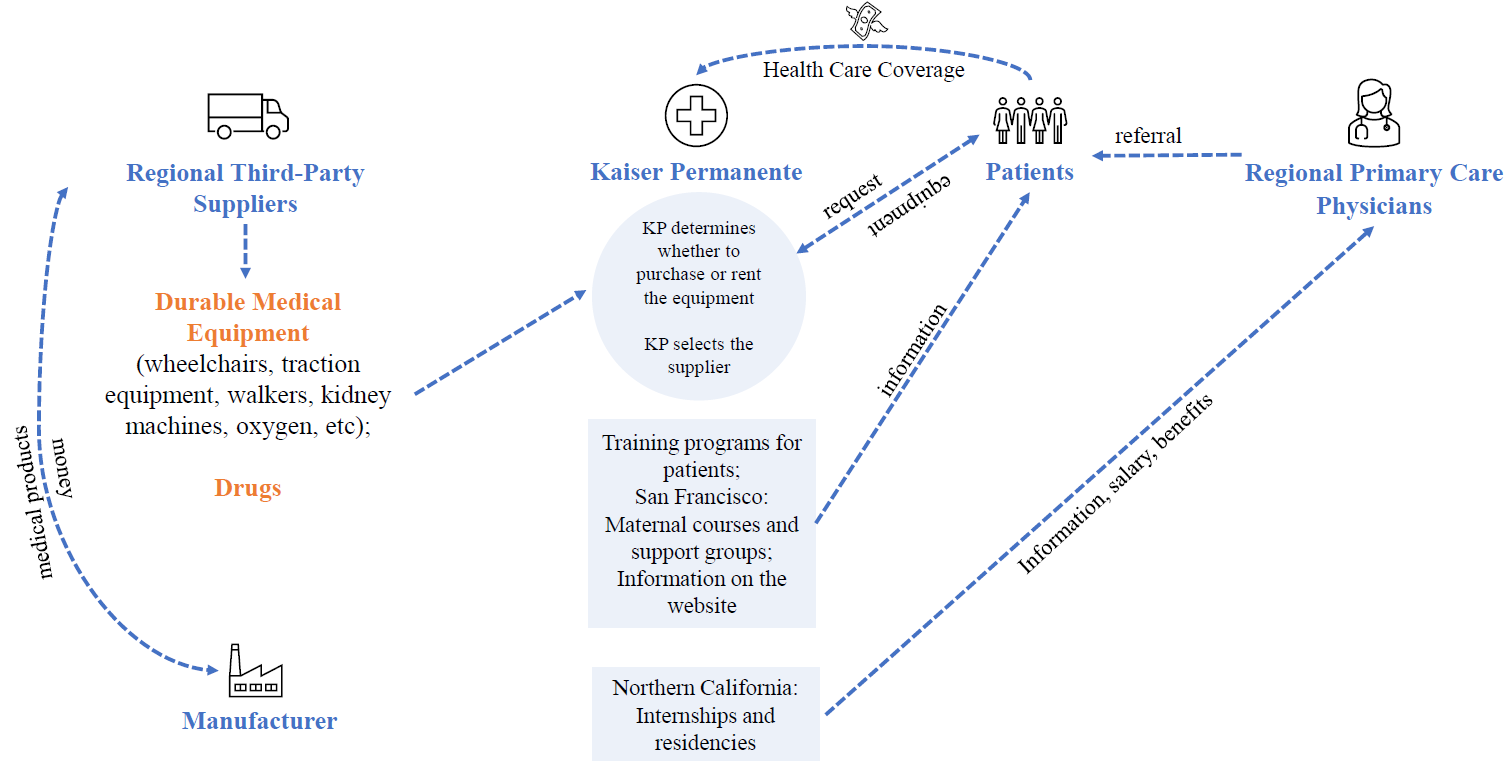
Supply Chain Plan
Kaiser Permanente (KP) is “one of America’s leading health care providers and not-for-profit health plans” (Kaiser Permanente (a), n.d., para.1). Currently, the company provides its services in eight American states and the District of Columbia. According to the data provided on the official website, KP’s healthcare services are used by 12.5 million people (Kaiser Permanente, n.d.). The critical objective of the KP is to provide its members with affordable healthcare services of high quality. The company’s supply planning includes such steps as distribution of durable medical equipment (DME), drugs, and information to the community members. KP does not manufacture medical products on its own. Therefore, the products that are supplied to the patients are retrieved from local third-party suppliers.
Value Chain and Flow of Structure
The concept of value chain refers to the range of activities that a business should undertake to provide a service or create a final good. In the case of KP, the value chain consists of two parts. The first part deals with the distribution of DME and drugs from the third-party suppliers to the patients. The companies from which KP purchases goods, in their turn, retrieve them from the manufacturers. To receive drugs or DME, a patient should send to the representative of KP a referral from the local primary care physician. When the request is received, the company decides whether the equipment should be rent or purchased and chooses the supplier. This service is available only to patients who have health care coverage. The second part of the value chain includes the provision of educational posts, training courses, and internships. These services are free for the consumers and are created directly by KP’s staff members.
Inputs
As it has been noted above, KP is a non-profit organization, not an insurance company. The point is that KP helps people with low income receive decent healthcare. Therefore, money for medical insurance is not the main income item. This way, KP’s inputs include the staff members’ labor and the administration and management of this system. KP’s inputs also include land and building because it provides medical assistance in its own medical offices and hospitals. Additionally, this company offers a list of hospitals with which it concluded cooperation agreements and which accept people with KP’s health insurance.
Outputs
KP does not receive profit from the services that it provides. Nonetheless, the critical output lies in the variety of services that patients could access. More precisely, the customer service structure includes a wide range of medical personnel from nurses and physician assistants to mental health specialists, educators, rehab workers, and pharmacists. The second kind of KP’s outputs is workplaces and opportunities for internships for doctors.
Inventory Points and Forecasting
The official sources do not contain information on KP’s demand planning. Nonetheless, according to the United States Census Bureau (2019), the number of Americans living in poverty is gradually reducing. From this, one could infer that the demand for KP’s healthcare coverage is falling. Nonetheless, the ongoing pandemic of COVID-19 should be taken into consideration. More precisely, this forced self-isolation left thousands of people without a stable monthly income. This way, it might be suggested that in the nearest future, demand for KP’s services will be high because of the complicated economic situation.
Sourcing Activities
The primary source of contracts for “contracts for various categories of goods and services that are purchased on a recurring basis” are internal stakeholders (Kaiser Permanente (b), n.d., para. 1). KP also cooperates with internal stakeholders on the issue of operationalization of the procurement of the previously purchased goods and services (Kaiser Permanente (b), n.d.). These stakeholders include Kaiser Permanente NTN Hubs and Kaiser Permanente home regions and individuals employed in KP such as physicians and the leadership team members.
Risks
The major risk that comes to mind when looking at KP’s supply chain diagram deals with the spread of information on the opportunities provided by KP. The second important point is that KP operates in eight states, and health and safety standards there are different. Therefore, it is impossible to create a universal scheme of provision of medical goods and services. For this reason, it is rather challenging to implement innovations, perform any centralized changes, or open branch offices in other states because KP in every single region should be managed independently. Furthermore, it is difficult to illuminate the possibility that the quality of services in every regional subdivision is of the same high quality.
Locations
KP operates in the District of Columbia, Northern and Southern California, Colorado, Georgia, Hawaii, Mid-Atlantic, and Northwest. The third-party suppliers are located in the same states as the KP offices do. Such a strategy helps to economize the cost of transferring products from one region to another. Additionally, as it has already been noted, health and safety standards vary in all states and purchasing goods from local suppliers protect from the legal issues with the violation of norms.
Logistics
The department of National Warehousing and Logistics is responsible for transportation, supply storage, distribution, and document services. KP outsources the elements of distribution and transportation of medical products to third-party logistics. KP makes strict delivery and shipping requirements for the contractors. Recently, KP has become concerned with the protection of the environment. Hence, it also obliges suppliers of logistic services to follow Kaiser Permanente Environmental Preferable Purchasing Standard.
References
Kaiser Permanente (a). (n.d.). Who we are. Web.
Kaiser Permanente (b). (n.d.). Vendor information. Web.
United States Census Bureau. (2019). Income and poverty in the United States: 2019. Web.
